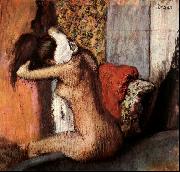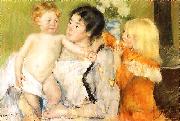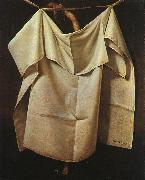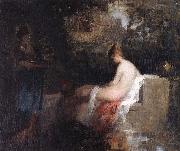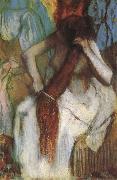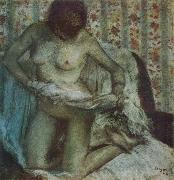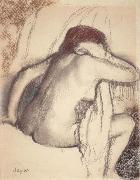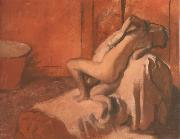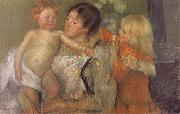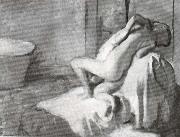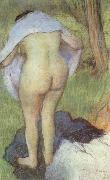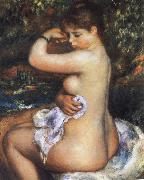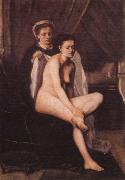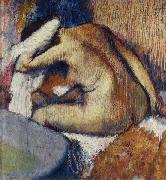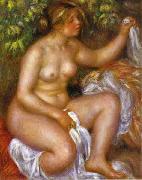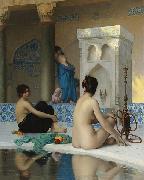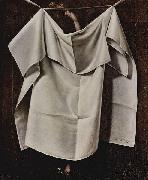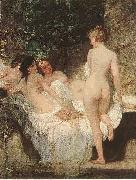Wholesale Oil Painting No Minimum |
|||||||||||
|
|
|||||||||||

|
|||||||||||
|
|
|
||||||||
Edgar DegasFrench Realist/Impressionist Painter and Sculptor, 1834-1917 French painter, draughtsman, printmaker, sculptor, pastellist, photographer and collector. He was a founder-member of the Impressionist group and the leader within it of the Realist tendency. He organized several of the group exhibitions, but after 1886 he showed his works very rarely and largely withdrew from the Parisian art world. As he was sufficiently wealthy, he was not constricted by the need to sell his work, and even his late pieces retain a vigour and a power to shock that is lacking in the contemporary productions of his Impressionist colleagues. |
||||||||
|
|
||||||||
After the Bath
After the Bath Painting ID:: 863 |
|
|||||||
|
|
||||||||
Mary Cassatt1844-1926 Mary Cassatt Galleries Within months of her return to Europe in the autumn of 1871, Cassatt??s prospects had brightened. Her painting Two Women Throwing Flowers During Carnival was well received in the Salon of 1872, and was purchased. She attracted much favorable notice in Parma and was supported and encouraged by the art community there: ??All Parma is talking of Miss Cassatt and her picture, and everyone is anxious to know her??. After completing her commission for the archbishop, Cassatt traveled to Madrid and Seville, where she painted a group of paintings of Spanish subjects, including Spanish Dancer Wearing a Lace Mantilla (1873, in the National Museum of American Art, Smithsonian Institution). In 1874, she made the decision to take up residence in France. She was joined by her sister Lydia who shared an apartment with her. Cassatt continued to express criticism of the politics of the Salon and the conventional taste that prevailed there. She was blunt in her comments, as reported by Sartain, who wrote: ??she is entirely too slashing, snubs all modern art, disdains the Salon pictures of Cabanel, Bonnat, all the names we are used to revere??. Cassatt saw that works by female artists were often dismissed with contempt unless the artist had a friend or protector on the jury, and she would not flirt with jurors to curry favor. Her cynicism grew when one of the two pictures she submitted in 1875 was refused by the jury, only to be accepted the following year after she darkened the background. She had quarrels with Sartain, who thought Cassatt too outspoken and self-centered, and eventually they parted. Out of her distress and self-criticism, Cassatt decided that she needed to move away from genre paintings and onto more fashionable subjects, in order to attract portrait commissions from American socialites abroad, but that attempt bore little fruit at first. In 1877, both her entries were rejected, and for the first time in seven years she had no works in the Salon. At this low point in her career she was invited by Edgar Degas to show her works with the Impressionists, a group that had begun their own series of independent exhibitions in 1874 with much attendant notoriety. The Impressionists (also known as the ??Independents?? or ??Intransigents??) had no formal manifesto and varied considerably in subject matter and technique. They tended to prefer open air painting and the application of vibrant color in separate strokes with little pre-mixing, which allows the eye to merge the results in an ??impressionistic?? manner. The Impressionists had been receiving the wrath of the critics for several years. Henry Bacon, a friend of the Cassatts, thought that the Impressionists were so radical that they were ??afflicted with some hitherto unknown disease of the eye??. They already had one female member, artist Berthe Morisot, who became Cassatt??s friend and colleague. Degas, Portrait of Miss Cassatt, Seated, Holding Cards, c. 1876-1878, oil on canvasCassatt admired Degas, whose pastels had made a powerful impression on her when she encountered them in an art dealer's window in 1875. "I used to go and flatten my nose against that window and absorb all I could of his art," she later recalled. "It changed my life. I saw art then as I wanted to see it." She accepted Degas' invitation with enthusiasm, and began preparing paintings for the next Impressionist show, planned for 1878, which (after a postponement because of the World??s Fair) took place on April 10, 1879. She felt comfortable with the Impressionists and joined their cause enthusiastically, declaring: ??we are carrying on a despairing fight & need all our forces??. Unable to attend cafes with them without attracting unfavorable attention, she met with them privately and at exhibitions. She now hoped for commercial success selling paintings to the sophisticated Parisians who preferred the avant-garde. Her style had gained a new spontaneity during the intervening two years. Previously a studio-bound artist, she had adopted the practice of carrying a sketchbook with her while out-of-doors or at the theater, and recording the scenes she saw. Summertime, c. 1894, oil on canvasIn 1877, Cassatt was joined in Paris by her father and mother, who returned with her sister Lydia. Mary valued their companionship, as neither she nor Lydia had married. Mary had decided early in life that marriage would be incompatible with her career. Lydia, who was frequently painted by her sister, suffered from recurrent bouts of illness, and her death in 1882 left Cassatt temporarily unable to work. Cassatt??s father insisted that her studio and supplies be covered by her sales, which were still meager. Afraid of having to paint ??potboilers?? to make ends meet, Cassatt applied herself to produce some quality paintings for the next Impressionist exhibition. Three of her most accomplished works from 1878 were Portrait of the Artist (self-portrait), Little Girl in a Blue Armchair, and Reading Le Figaro (portrait of her mother). Degas had considerable influence on Cassatt. She became extremely proficient in the use of pastels, eventually creating many of her most important works in this medium. Degas also introduced her to etching, of which he was a recognized master. The two worked side-by-side for awhile, and her draftsmanship gained considerable strength under his tutelage. He depicted her in a series of etchings recording their trips to the Louvre. She had strong feelings for him but learned not to expect too much from his fickle and temperamental nature. The sophisticated and well-dressed Degas, then forty-five, was a welcome dinner guest at the Cassatt residence. The Impressionist exhibit of 1879 was the most successful to date, despite the absence of Renoir, Sisley, Manet and C??zanne, who were attempting once again to gain recognition at the Salon. Through the efforts of Gustave Caillebotte, who organized and underwrote the show, the group made a profit and sold many works, although the criticism continued as harsh as ever. The Revue des Deux Mondes wrote, ??M. Degas and Mlle. Cassatt are, nevertheless, the only artists who distinguish themselves??and who offer some attraction and some excuse in the pretentious show of window dressing and infantile daubing??. Cassatt displayed eleven works, including La Loge. Although critics claimed that Cassatt??s colors were too bright and that her portraits were too accurate to be flattering to the subjects, her work was not savaged as was Monet's, whose circumstances were the most desperate of all the Impressionists at that time. She used her share of the profits to purchase a work by Degas and one by Monet. She exhibited in the Impressionist Exhibitions that followed in 1880 and 1881, and she remained an active member of the Impressionist circle until 1886. In 1886, Cassatt provided two paintings for the first Impressionist exhibition in the United States, organized by art dealer Paul Durand-Ruel. Her friend Louisine Elder married Harry Havemeyer in 1883, and with Cassatt as advisor, the couple began collecting the Impressionists on a grand scale. Much of their vast collection is now in the Metropolitan Museum of Art in New York City. She also made several portraits of family members during that period, of which Portrait of Alexander Cassatt and His Son Robert Kelso (1885) is one of her best regarded. Cassatt??s style then evolved, and she moved away from Impressionism to a simpler, more straightforward approach. She began to exhibit her works in New York galleries as well. After 1886, Cassatt no longer identified herself with any art movement and experimented with a variety of techniques. |
||||||||
|
|
||||||||
After the Bath
After the Bath Painting ID:: 3142 |
|
|||||||
|
|
||||||||
Raphaelle Peale1774-1825 Peale was born in Philadelphia as the son and first child of Rachel and Charles Willson Peale, a famous portraitist. Lived in Philadelphia, on a home at the corner of 3rd and Lombard. Married Martha (Patty) McGlathery at the age of 20. First first professional exhibition was in 1795 at the age of 21. Artist. Born Raphaelle Peale in Annapolis, Maryland on February 17, 1774, the fifth child, though eldest surviving, of Charles Willson Peale and his first wife Rachel Brewer. As with all the Peale children, Raphael was trained by his father as an artist. Early in his career, the pair collaborated on portraits. On some commissions, Raphael painted miniatures while his brother, Rembrandt, painted full size portraits. In 1792, he made a trip to South America in order to collect specimens for the Peale's Museum. In 1797, with his brother Rembrandt, he traveled to Charleston, South Carolina, where they attempted to establish another museum. The plan fell through, however, and Raphael returned to painting miniatures. He married Martha McGlathery at about that same time, and with her had eight children. For about two years beginning in 1803, Raphael toured Virginia with the ??physiognotrace,' a profile making machine, with which he was briefly successful. In August 1808, he was hospitalized with delirium tremens, exacerbated by severe gout. By 1813, he was unable to walk without crutches. After the downturn in his health, in an era when most artists considered still life a subject worthy only of amateurs, he devoted himself almost exclusively to still life painting. It is for these works he is best known. Raphael Peale is today considered the founder of the American Still Life school. His work was on frequent exhibit at the Pennsylvania Academy of the Fine Arts between 1814 and 1818. After reportedly indulging in a night of heavy drinking, his health destroyed, Raphael died on March 3, 1825 at age 51 at his home in Philadelphia. Peale's tightly grouped still lifes are often permeated with a delicate melancholy akin to that which characterized the life of the artist; he was an alcoholic who suffered the effects of arsenic and mercury poisoning caused by his work as a taxidermist in his father's museum. His spare, essential style may have been influenced by the Spanish still lifes he studied in Mexico and by the works of Juan Sanchez Cotan, exhibited at the Pennsylvania Academy in 1818. |
||||||||
|
|
||||||||
After the Bath
After the Bath Painting ID:: 4271 |
1823 1823 |
|||||||
|
|
||||||||
Emile Bernard1868-1941 French Emile Bernard Galleries (b Lille, 28 April 1868; d Paris, 15 April 1941). French painter and writer. He was the son of a cloth merchant. Relations with his parents were never harmonious, and in 1884, against his fathers wishes, he enrolled as a student at the Atelier Cormon in Paris. There he became a close friend of Louis Anquetin and Toulouse-Lautrec. In suburban views of Asnires, where his parents lived, Bernard experimented with Impressionist and then Pointillist colour theory, in direct opposition to his masters academic teaching; an argument with Fernand Cormon led to his expulsion from the studio in 1886. He made a walking tour of Normandy and Brittany that year, drawn to Gothic architecture and the simplicity of the carved Breton calvaries. In Concarneau he struck up a friendship with Claude-Emile Schuffenecker and met Gauguin briefly in Pont-Aven. During the winter Bernard met van Gogh and frequented the shop of the colour merchant Julien-Franois Tanguy, where he gained access to the little-known work of Cezanne. |
||||||||
|
|
||||||||
After the Bath
After the Bath Painting ID:: 11650 |
the Nymphs,1908
3' 11 3/4'' x 4' 11 1/2''(121 x 151 cm)Gift of Paul Jamot,1931 the Nymphs,1908 3' 11 3/4'' x 4' 11 1/2''(121 x 151 cm)Gift of Paul Jamot,1931 |
|||||||
|
|
||||||||
Nicolae GrigorescuRomanian Painter, 1838-1907 From 1848 he trained in Bucharest with various church painters, producing icons and religious mural decorations. These works, which soon attracted attention, were influenced in style by the Viennese classicism widespread in the Romanian principalities in the early 19th century and by the Italian academicism established there after 1850 by Gheorghe Tattarescu. The earliest of his known paintings are in the church of SS Constantin and Elena at Baicoi, where his signature can be seen beside that of Nita Pereescu on the icon of St George (1853). He subsequently painted a series of icons (1854-5) at Caldarusani Monastery. In the later ensembles he was assisted by his older brother Georghe Grigorescu, who participated under his direction in the decoration of churches, such as those of the Zamfira (1856-8) and Agapia (1858-60) monasteries. In Nicolae's paintings at Agapia, classicism in Romanian art reached its highest point. The royal icons are distinguished for the elegance of the figures, both in their attitudes and in their drapery. |
||||||||
|
|
||||||||
After the Bath
After the Bath Painting ID:: 30804 |
nn06
oil on canvas
33x38.5cm
National Art Museum of Romania,
Bucharest
nn06 oil on canvas 33x38.5cm National Art Museum of Romania, Bucharest |
|||||||
|
|
||||||||
Edgar DegasFrench Realist/Impressionist Painter and Sculptor, 1834-1917 French painter, draughtsman, printmaker, sculptor, pastellist, photographer and collector. He was a founder-member of the Impressionist group and the leader within it of the Realist tendency. He organized several of the group exhibitions, but after 1886 he showed his works very rarely and largely withdrew from the Parisian art world. As he was sufficiently wealthy, he was not constricted by the need to sell his work, and even his late pieces retain a vigour and a power to shock that is lacking in the contemporary productions of his Impressionist colleagues. |
||||||||
|
|
||||||||
After the Bath
After the Bath Painting ID:: 37760 |
mk128
80x56.8cm
About 1887-1890
mk128 80x56.8cm About 1887-1890 |
|||||||
|
|
||||||||
Edgar DegasFrench Realist/Impressionist Painter and Sculptor, 1834-1917 French painter, draughtsman, printmaker, sculptor, pastellist, photographer and collector. He was a founder-member of the Impressionist group and the leader within it of the Realist tendency. He organized several of the group exhibitions, but after 1886 he showed his works very rarely and largely withdrew from the Parisian art world. As he was sufficiently wealthy, he was not constricted by the need to sell his work, and even his late pieces retain a vigour and a power to shock that is lacking in the contemporary productions of his Impressionist colleagues. |
||||||||
|
|
||||||||
After the Bath
After the Bath Painting ID:: 41091 |
mk159
1884
Pastel on paper mounted on cardboard
50x50cm
mk159 1884 Pastel on paper mounted on cardboard 50x50cm |
|||||||
|
|
||||||||
Edgar DegasFrench Realist/Impressionist Painter and Sculptor, 1834-1917 French painter, draughtsman, printmaker, sculptor, pastellist, photographer and collector. He was a founder-member of the Impressionist group and the leader within it of the Realist tendency. He organized several of the group exhibitions, but after 1886 he showed his works very rarely and largely withdrew from the Parisian art world. As he was sufficiently wealthy, he was not constricted by the need to sell his work, and even his late pieces retain a vigour and a power to shock that is lacking in the contemporary productions of his Impressionist colleagues. |
||||||||
|
|
||||||||
After The Bath
After The Bath Painting ID:: 49176 |
mk194
c.1892-94
mk194 c.1892-94 |
|||||||
|
|
||||||||
Edgar DegasFrench Realist/Impressionist Painter and Sculptor, 1834-1917 French painter, draughtsman, printmaker, sculptor, pastellist, photographer and collector. He was a founder-member of the Impressionist group and the leader within it of the Realist tendency. He organized several of the group exhibitions, but after 1886 he showed his works very rarely and largely withdrew from the Parisian art world. As he was sufficiently wealthy, he was not constricted by the need to sell his work, and even his late pieces retain a vigour and a power to shock that is lacking in the contemporary productions of his Impressionist colleagues. |
||||||||
|
|
||||||||
After the Bath
After the Bath Painting ID:: 49213 |
mk194
1896
Oil on canvas
89x116cm
mk194 1896 Oil on canvas 89x116cm |
|||||||
|
|
||||||||
Mary Cassatt1844-1926 Mary Cassatt Galleries Within months of her return to Europe in the autumn of 1871, Cassatt??s prospects had brightened. Her painting Two Women Throwing Flowers During Carnival was well received in the Salon of 1872, and was purchased. She attracted much favorable notice in Parma and was supported and encouraged by the art community there: ??All Parma is talking of Miss Cassatt and her picture, and everyone is anxious to know her??. After completing her commission for the archbishop, Cassatt traveled to Madrid and Seville, where she painted a group of paintings of Spanish subjects, including Spanish Dancer Wearing a Lace Mantilla (1873, in the National Museum of American Art, Smithsonian Institution). In 1874, she made the decision to take up residence in France. She was joined by her sister Lydia who shared an apartment with her. Cassatt continued to express criticism of the politics of the Salon and the conventional taste that prevailed there. She was blunt in her comments, as reported by Sartain, who wrote: ??she is entirely too slashing, snubs all modern art, disdains the Salon pictures of Cabanel, Bonnat, all the names we are used to revere??. Cassatt saw that works by female artists were often dismissed with contempt unless the artist had a friend or protector on the jury, and she would not flirt with jurors to curry favor. Her cynicism grew when one of the two pictures she submitted in 1875 was refused by the jury, only to be accepted the following year after she darkened the background. She had quarrels with Sartain, who thought Cassatt too outspoken and self-centered, and eventually they parted. Out of her distress and self-criticism, Cassatt decided that she needed to move away from genre paintings and onto more fashionable subjects, in order to attract portrait commissions from American socialites abroad, but that attempt bore little fruit at first. In 1877, both her entries were rejected, and for the first time in seven years she had no works in the Salon. At this low point in her career she was invited by Edgar Degas to show her works with the Impressionists, a group that had begun their own series of independent exhibitions in 1874 with much attendant notoriety. The Impressionists (also known as the ??Independents?? or ??Intransigents??) had no formal manifesto and varied considerably in subject matter and technique. They tended to prefer open air painting and the application of vibrant color in separate strokes with little pre-mixing, which allows the eye to merge the results in an ??impressionistic?? manner. The Impressionists had been receiving the wrath of the critics for several years. Henry Bacon, a friend of the Cassatts, thought that the Impressionists were so radical that they were ??afflicted with some hitherto unknown disease of the eye??. They already had one female member, artist Berthe Morisot, who became Cassatt??s friend and colleague. Degas, Portrait of Miss Cassatt, Seated, Holding Cards, c. 1876-1878, oil on canvasCassatt admired Degas, whose pastels had made a powerful impression on her when she encountered them in an art dealer's window in 1875. "I used to go and flatten my nose against that window and absorb all I could of his art," she later recalled. "It changed my life. I saw art then as I wanted to see it." She accepted Degas' invitation with enthusiasm, and began preparing paintings for the next Impressionist show, planned for 1878, which (after a postponement because of the World??s Fair) took place on April 10, 1879. She felt comfortable with the Impressionists and joined their cause enthusiastically, declaring: ??we are carrying on a despairing fight & need all our forces??. Unable to attend cafes with them without attracting unfavorable attention, she met with them privately and at exhibitions. She now hoped for commercial success selling paintings to the sophisticated Parisians who preferred the avant-garde. Her style had gained a new spontaneity during the intervening two years. Previously a studio-bound artist, she had adopted the practice of carrying a sketchbook with her while out-of-doors or at the theater, and recording the scenes she saw. Summertime, c. 1894, oil on canvasIn 1877, Cassatt was joined in Paris by her father and mother, who returned with her sister Lydia. Mary valued their companionship, as neither she nor Lydia had married. Mary had decided early in life that marriage would be incompatible with her career. Lydia, who was frequently painted by her sister, suffered from recurrent bouts of illness, and her death in 1882 left Cassatt temporarily unable to work. Cassatt??s father insisted that her studio and supplies be covered by her sales, which were still meager. Afraid of having to paint ??potboilers?? to make ends meet, Cassatt applied herself to produce some quality paintings for the next Impressionist exhibition. Three of her most accomplished works from 1878 were Portrait of the Artist (self-portrait), Little Girl in a Blue Armchair, and Reading Le Figaro (portrait of her mother). Degas had considerable influence on Cassatt. She became extremely proficient in the use of pastels, eventually creating many of her most important works in this medium. Degas also introduced her to etching, of which he was a recognized master. The two worked side-by-side for awhile, and her draftsmanship gained considerable strength under his tutelage. He depicted her in a series of etchings recording their trips to the Louvre. She had strong feelings for him but learned not to expect too much from his fickle and temperamental nature. The sophisticated and well-dressed Degas, then forty-five, was a welcome dinner guest at the Cassatt residence. The Impressionist exhibit of 1879 was the most successful to date, despite the absence of Renoir, Sisley, Manet and C??zanne, who were attempting once again to gain recognition at the Salon. Through the efforts of Gustave Caillebotte, who organized and underwrote the show, the group made a profit and sold many works, although the criticism continued as harsh as ever. The Revue des Deux Mondes wrote, ??M. Degas and Mlle. Cassatt are, nevertheless, the only artists who distinguish themselves??and who offer some attraction and some excuse in the pretentious show of window dressing and infantile daubing??. Cassatt displayed eleven works, including La Loge. Although critics claimed that Cassatt??s colors were too bright and that her portraits were too accurate to be flattering to the subjects, her work was not savaged as was Monet's, whose circumstances were the most desperate of all the Impressionists at that time. She used her share of the profits to purchase a work by Degas and one by Monet. She exhibited in the Impressionist Exhibitions that followed in 1880 and 1881, and she remained an active member of the Impressionist circle until 1886. In 1886, Cassatt provided two paintings for the first Impressionist exhibition in the United States, organized by art dealer Paul Durand-Ruel. Her friend Louisine Elder married Harry Havemeyer in 1883, and with Cassatt as advisor, the couple began collecting the Impressionists on a grand scale. Much of their vast collection is now in the Metropolitan Museum of Art in New York City. She also made several portraits of family members during that period, of which Portrait of Alexander Cassatt and His Son Robert Kelso (1885) is one of her best regarded. Cassatt??s style then evolved, and she moved away from Impressionism to a simpler, more straightforward approach. She began to exhibit her works in New York galleries as well. After 1886, Cassatt no longer identified herself with any art movement and experimented with a variety of techniques. |
||||||||
|
|
||||||||
After the bath
After the bath Painting ID:: 49889 |
mk205
about 1901
oil on canvas
66x100cm
mk205 about 1901 oil on canvas 66x100cm |
|||||||
|
|
||||||||
Edgar DegasFrench Realist/Impressionist Painter and Sculptor, 1834-1917 French painter, draughtsman, printmaker, sculptor, pastellist, photographer and collector. He was a founder-member of the Impressionist group and the leader within it of the Realist tendency. He organized several of the group exhibitions, but after 1886 he showed his works very rarely and largely withdrew from the Parisian art world. As he was sufficiently wealthy, he was not constricted by the need to sell his work, and even his late pieces retain a vigour and a power to shock that is lacking in the contemporary productions of his Impressionist colleagues. |
||||||||
|
|
||||||||
After the bath
After the bath Painting ID:: 50008 |
mk206
about 1896
Oil on canvas
89x116cm
mk206 about 1896 Oil on canvas 89x116cm |
|||||||
|
|
||||||||
Edgar DegasFrench Realist/Impressionist Painter and Sculptor, 1834-1917 French painter, draughtsman, printmaker, sculptor, pastellist, photographer and collector. He was a founder-member of the Impressionist group and the leader within it of the Realist tendency. He organized several of the group exhibitions, but after 1886 he showed his works very rarely and largely withdrew from the Parisian art world. As he was sufficiently wealthy, he was not constricted by the need to sell his work, and even his late pieces retain a vigour and a power to shock that is lacking in the contemporary productions of his Impressionist colleagues. |
||||||||
|
|
||||||||
After the Bath
After the Bath Painting ID:: 54099 |
mk235
1885
Oil on canvas
80x51.2cm
mk235 1885 Oil on canvas 80x51.2cm |
|||||||
|
|
||||||||
Pierre-Auguste RenoirFrench Impressionist Painter, 1841-1919 French painter, printmaker and sculptor. He was one of the founders and leading exponents of IMPRESSIONISM from the late 1860s, producing some of the movement's most famous images of carefree leisure. He broke with his Impressionist colleagues to exhibit at the Salon from 1878, and from c. 1884 he adopted a more linear style indebted to the Old Masters. His critical reputation has suffered from the many minor works he produced during his later years. |
||||||||
|
|
||||||||
After the Bath
After the Bath Painting ID:: 54165 |
mk235
1888
Oil on canvas
65x54cm
mk235 1888 Oil on canvas 65x54cm |
|||||||
|
|
||||||||
Frederic Bazilleb.Dec. 6, 1841, Montpellier, France d.Nov. 28, 1870, Beaune-la-Rolande French Frederic Bazille Galleries was a French Impressionist painter best known for his depiction of figures. Born in Montpellier, Herault, Languedoc-Roussillon, into a middle-class Protestant family, Bazille became interested in painting after seeing some works of Eugene Delacroix. His family agreed to let him study painting, but only if he also studied medicine. Bazille began studying medicine in 1859. He moved to Paris in 1862 to continue his studies. There he met Pierre-Auguste Renoir, was drawn to Impressionist painting, and began taking classes in Charles Gleyres studio. After failing his medical exam in 1864, he began painting full-time. His close friends included Claude Monet, Alfred Sisley, and Édouard Manet. Born to a wealthy family, Bazille helped support some of these artists by giving them space in his studio and materials to use. Bazille was just twenty-three years old when he painted several famous works, including The Pink Dress. His best known painting is Family Reunion (1867?C1868). |
||||||||
|
|
||||||||
After the Bath
After the Bath Painting ID:: 54574 |
mk235
1870
oil on canvas
mk235 1870 oil on canvas |
|||||||
|
|
||||||||
Edgar DegasFrench Realist/Impressionist Painter and Sculptor, 1834-1917 French painter, draughtsman, printmaker, sculptor, pastellist, photographer and collector. He was a founder-member of the Impressionist group and the leader within it of the Realist tendency. He organized several of the group exhibitions, but after 1886 he showed his works very rarely and largely withdrew from the Parisian art world. As he was sufficiently wealthy, he was not constricted by the need to sell his work, and even his late pieces retain a vigour and a power to shock that is lacking in the contemporary productions of his Impressionist colleagues. |
||||||||
|
|
||||||||
After the Bath
After the Bath Painting ID:: 58628 |
After the Bath, 1896-1898
After the Bath, 1896-1898 |
|||||||
|
|
||||||||
Edgar DegasFrench Realist/Impressionist Painter and Sculptor, 1834-1917 French painter, draughtsman, printmaker, sculptor, pastellist, photographer and collector. He was a founder-member of the Impressionist group and the leader within it of the Realist tendency. He organized several of the group exhibitions, but after 1886 he showed his works very rarely and largely withdrew from the Parisian art world. As he was sufficiently wealthy, he was not constricted by the need to sell his work, and even his late pieces retain a vigour and a power to shock that is lacking in the contemporary productions of his Impressionist colleagues. |
||||||||
|
|
||||||||
After the Bath
After the Bath Painting ID:: 58629 |
After the Bath, Woman Drying her Nape 1898, Mus??e d'Orsay, Paris, France
After the Bath, Woman Drying her Nape 1898, Mus??e d'Orsay, Paris, France |
|||||||
|
|
||||||||
Pierre-Auguste RenoirFrench Impressionist Painter, 1841-1919 French painter, printmaker and sculptor. He was one of the founders and leading exponents of IMPRESSIONISM from the late 1860s, producing some of the movement's most famous images of carefree leisure. He broke with his Impressionist colleagues to exhibit at the Salon from 1878, and from c. 1884 he adopted a more linear style indebted to the Old Masters. His critical reputation has suffered from the many minor works he produced during his later years. |
||||||||
|
|
||||||||
After The Bath
After The Bath Painting ID:: 60495 |
After The Bath, 1910, Barnes Foundation, Merion Pennsylvania
After The Bath, 1910, Barnes Foundation, Merion Pennsylvania |
|||||||
|
|
||||||||
Jean-Leon GeromeFrench Academic Painter and Sculptor, 1824-1904 was a French painter and sculptor in the style now known as Academicism. The range of his oeuvre included historical painting, Greek mythology, Orientalism, portraits and other subjects, bringing the Academic painting tradition to an artistic climax. Born at Vesoul (Haute-Saône), he went to Paris in 1840 where he studied under Paul Delaroche, whom he accompanied to Italy (1843-1844). He visited Florence, Rome, the Vatican and Pompeii, but he was more attracted to the world of nature. Taken by a fever, he was forced to return to Paris in 1844. On his return he followed, like many other students of Delaroche, into the atelier of Charles Gleyre and studied there for a brief time. He then attended the Ecole des Beaux-Arts. In 1846 he tried to enter the prestigious Prix de Rome, but failed in the final stage because his figure drawing was inadequate. He tried to improve his skills by painting The Cockfight (1846), an academic exercise depicting a nude young man and a lightly draped girl with two fighting cocks and in the background the Bay of Naples. He sent this painting to the Salon of 1847, where it gained him a third-class medal. This work was seen as the epitome of the Neo-Grec movement that had formed out of Gleyre's studio (such as Henri-Pierre Picou (1824-1895) and Jean-Louis Hamon), and was championed by the influential French critic Theophile Gautier. G??rôme abandoned his dream of winning the Prix de Rome and took advantage of his sudden success. His paintings The Virgin, the Infant Jesus and St John (private collection) and Anacreon, Bacchus and Cupid (Mus??e des Augustins, Toulouse, France) took a second-class medal in 1848. In 1849 he produced the paintings Michelangelo (also called In his studio) (now in private collection) image of the painting and A portrait of a Lady (Mus??e Ingres, Montauban). In 1851 he decorated a vase, later offered by Emperor Napoleon III of France to Prince Albert, now part of the Royal Collection at St. James's Palace, London. He exhibited Bacchus and Love, Drunk, a Greek Interior and Souvenir d'Italie, in 1851; Paestum (1852); and An Idyll (1853). In 1852 G??rôme received a commission by Alfred Emilien Comte de Nieuwerkerke, Surintendant des Beaux-Arts to the court of Napoleon III, for the painting of a large historical canvas, the Age of Augustus image of the painting. In this canvas he combines the birth of Christ with conquered nations paying homage to Augustus. Thanks to a considerable down payment, he was able to travel in 1853 to Constantinople, together with the actor Edmond Got. This would be the first of several travels to the East : in 1854 he made another journey to Turkey and the shores of the Danube, where he was present at a concert of Russian conscripts, making music under the threat of a lash. In 1854 he completed another important commission of decorating the Chapel of St. Jerome in the church of St. S??verin in Paris. His Last communion of St. Jerome in this chapel reflects the influence of the school of Ingres on his religious works. To the exhibition of 1855 he contributed a Pifferaro, a Shepherd, A Russian Concert, The Age of Augustus and Birth of Christ. |
||||||||
|
|
||||||||
After the Bath
After the Bath Painting ID:: 81830 |
Medium English: Oil on canvas
Dimensions English: 82.6 x 66.7 cm
cjr Medium English: Oil on canvas Dimensions English: 82.6 x 66.7 cm cjr |
|||||||
|
|
||||||||
Raphaelle Peale1774-1825 Peale was born in Philadelphia as the son and first child of Rachel and Charles Willson Peale, a famous portraitist. Lived in Philadelphia, on a home at the corner of 3rd and Lombard. Married Martha (Patty) McGlathery at the age of 20. First first professional exhibition was in 1795 at the age of 21. Artist. Born Raphaelle Peale in Annapolis, Maryland on February 17, 1774, the fifth child, though eldest surviving, of Charles Willson Peale and his first wife Rachel Brewer. As with all the Peale children, Raphael was trained by his father as an artist. Early in his career, the pair collaborated on portraits. On some commissions, Raphael painted miniatures while his brother, Rembrandt, painted full size portraits. In 1792, he made a trip to South America in order to collect specimens for the Peale's Museum. In 1797, with his brother Rembrandt, he traveled to Charleston, South Carolina, where they attempted to establish another museum. The plan fell through, however, and Raphael returned to painting miniatures. He married Martha McGlathery at about that same time, and with her had eight children. For about two years beginning in 1803, Raphael toured Virginia with the ??physiognotrace,' a profile making machine, with which he was briefly successful. In August 1808, he was hospitalized with delirium tremens, exacerbated by severe gout. By 1813, he was unable to walk without crutches. After the downturn in his health, in an era when most artists considered still life a subject worthy only of amateurs, he devoted himself almost exclusively to still life painting. It is for these works he is best known. Raphael Peale is today considered the founder of the American Still Life school. His work was on frequent exhibit at the Pennsylvania Academy of the Fine Arts between 1814 and 1818. After reportedly indulging in a night of heavy drinking, his health destroyed, Raphael died on March 3, 1825 at age 51 at his home in Philadelphia. Peale's tightly grouped still lifes are often permeated with a delicate melancholy akin to that which characterized the life of the artist; he was an alcoholic who suffered the effects of arsenic and mercury poisoning caused by his work as a taxidermist in his father's museum. His spare, essential style may have been influenced by the Spanish still lifes he studied in Mexico and by the works of Juan Sanchez Cotan, exhibited at the Pennsylvania Academy in 1818. |
||||||||
|
|
||||||||
After the Bath
After the Bath Painting ID:: 83644 |
Oil on canvas
English: Oil on Canvas
Dimensions Deutsch: 74.3 x 61.3 cm
English: 29 1/4" x 24 1/8"
cyf Oil on canvas English: Oil on Canvas Dimensions Deutsch: 74.3 x 61.3 cm English: 29 1/4" x 24 1/8" cyf |
|||||||
|
|
||||||||
Lotz, KarolyHungarian Painter, 1833-1904 was a German-Hungarian painter. Karl Lotz was born in Bad Homburg vor der Höhe, Germany, the seventh and youngest surviving child of Wilhelm Christian Lotz and Antonia Höfflick. His father was a valet of Prince Gustav zu Hessen-Homburg at the time when the prince was representing Austria at the Congress of Vienna, which among other matters dealt with the House of Hessen-Homburg's rights of sovereignty over Hessen-Darmstadt. The sudden death of the young Baron von Sinclair, charge d'affaires, forced W. C. Lotz temporarily into the rôle. While in Hungary in 1815 he made the acquaintance of the 13-year-old Antonie Hoefflich, whom he married three years later. She gave birth to eight children, of whom Karl was the youngest. W. C. Lotz died in 1837 and Antonie moved the family to Pest (now that part of Budapest to the north of the River Danube). Karl attended the Piaristengymnasium, where, although Calvinist, he was awarded a scholarship for his exceptional academic performance. He began his artistic career as a pupil of the Hofkapellmeister Destouches, then in the academy of the Venetian master Jacopo Marastoni (1804-1860). Later he was a pupil of the historical painters Henrik Weber (1818-1866) in Budapest and Carl Rahl (1812-1865) in Vienna. Together with Rahl he worked on numerous commissions. Later he started on his own original works, first as a romantic landscape artist in scenes of the Alföld (the Hungarian lowland plain), and then as a creator of monumental murals and frescos in the style of the Venetian master Tiepolo. After various works in Budapest he became active in Vienna. He laid out plans for a grandiose palace, and completed murals commissioned by the Abbot of Tihany for his abbey church on the shore of Lake Balaton. He became known for his portraits and nudes, for which both his wife and his daughters (Katarina in particular) posed. Lotz found married bliss only at the age of 58, when he married the widow Jacoboy, the former wife of his brother Paul Johann Heinrich, who had died in 1828. From then on he signed his works Keroly Jacoboy-Lotz. In 1882 Lotz was appointed Professor at various art academies in Budapest, and in 1885 he became dean of a newly-established department for women painters. |
||||||||
|
|
||||||||
After the Bath
After the Bath Painting ID:: 95590 |
1880(1880)
Medium oil on canvas
cyf 1880(1880) Medium oil on canvas cyf |
|||||||
|
|
||||||||
|
Lotz, Karoly Hungarian Painter, 1833-1904 was a German-Hungarian painter. Karl Lotz was born in Bad Homburg vor der Höhe, Germany, the seventh and youngest surviving child of Wilhelm Christian Lotz and Antonia Höfflick. His father was a valet of Prince Gustav zu Hessen-Homburg at the time when the prince was representing Austria at the Congress of Vienna, which among other matters dealt with the House of Hessen-Homburg's rights of sovereignty over Hessen-Darmstadt. The sudden death of the young Baron von Sinclair, charge d'affaires, forced W. C. Lotz temporarily into the rôle. While in Hungary in 1815 he made the acquaintance of the 13-year-old Antonie Hoefflich, whom he married three years later. She gave birth to eight children, of whom Karl was the youngest. W. C. Lotz died in 1837 and Antonie moved the family to Pest (now that part of Budapest to the north of the River Danube). Karl attended the Piaristengymnasium, where, although Calvinist, he was awarded a scholarship for his exceptional academic performance. He began his artistic career as a pupil of the Hofkapellmeister Destouches, then in the academy of the Venetian master Jacopo Marastoni (1804-1860). Later he was a pupil of the historical painters Henrik Weber (1818-1866) in Budapest and Carl Rahl (1812-1865) in Vienna. Together with Rahl he worked on numerous commissions. Later he started on his own original works, first as a romantic landscape artist in scenes of the Alföld (the Hungarian lowland plain), and then as a creator of monumental murals and frescos in the style of the Venetian master Tiepolo. After various works in Budapest he became active in Vienna. He laid out plans for a grandiose palace, and completed murals commissioned by the Abbot of Tihany for his abbey church on the shore of Lake Balaton. He became known for his portraits and nudes, for which both his wife and his daughters (Katarina in particular) posed. Lotz found married bliss only at the age of 58, when he married the widow Jacoboy, the former wife of his brother Paul Johann Heinrich, who had died in 1828. From then on he signed his works Keroly Jacoboy-Lotz. In 1882 Lotz was appointed Professor at various art academies in Budapest, and in 1885 he became dean of a newly-established department for women painters. After the Bath 1880(1880) Medium oil on canvas cyf |
||||||||
|
|
||||||||
|
Prev Next
|
||||||||
|
|
||||||||
|
Related Paintings to Lotz, Karoly :. |
||||||||
|
|
||||||||
|
CONTACT US |
